Don't wanna be here? Send us removal request.
Text
New Value Transactions

I attended a workshop at DIS2017 on New Value Transactions: Understanding and Designing for Distributed Autonomous Organisations. It was a design oriented workshop on how value is (or might be) exchanged via blockchains and smart contracts.
The day started with a discussion of several existing blockchain projects, including BitBarista (a coffee machine that shows the provenance of the coffee it uses), Decentraland (which uses blockchain to record ownership in VR), Terra0 (an ‘autonomous forest’), and Faircoin (a cryptocurrency supported by a ‘cooperative grassroots movement’).
Ten position papers were presented. Mine was on Trustless Education? A Blockchain System for University Grades.

The afternoon was spent working on clustering what we saw as problems and opportunities in this area. Topics included Trust, Participation, Literacies, New Organisations, and Governance. We then worked in small groups looking at value transactions in particular contexts and what the role of smart contracts and distributed autonomous organisations might be. I was in a group looking at food. We considered school meals and how blockchain technology might be used in the supply chain or within schools themselves to produce healthier and more sustainable meals or to minimise and redistribute waste.
The workshop was interesting and helpful. My thoughts following the workshop are:
There are interesting opportunities for value exchange with blockchain beyond payments. Many academics seem interested in using blockchain to support/enable autonomy of ‘things’ and animals. Many also see potential in the exchange of social value and technology for public good.
We should not just think about automation with smart contracts but also support for forms of human interaction. One interesting area is consent by voting- what happens if one needs peer consent to turn on the air conditioning or to maintain a ‘vegetarian identity’?
We should consider the temporalities of blockchain. We should consider the “waitings” that happen during execution; what kinds of interaction can happen across slow technology and what happens while you wait? There’s also a tension (or confusion) between the permanency of smart contracts and a presumption of technical/contractual change.
New forms of power in this domain will arise from governance and technical literacy rather than ownership. Academics are optimistic and idealistic when it comes to the potential of this technology, which may serve to bring positive potentials in this area, but might also mean we’re blind to negatives.
Its difficult to consider where blockchains may fit within existing organisations. Innovation will probably happen outside of these contexts. The technology is also difficult to understand (as Chris Speed put it, its difficult to hold more than 5 of the 7 apples at the same time). This difficulty is problematic for designers and academics, and even more so for broader publics- these systems can’t be transparent and ‘trustless’ if we don’t understand them.
A key issue in this area for us as designers and potential users/beneficiaries/subjects is that blockchain technology is complex and specific potentials and effects are difficult to envisage. I think it will be useful to ground further discussions in this domain in prototyping. Maybe I’m not thinking big enough, but I don’t think the important academic concerns are with organisations and legal systems. I think the potential of this technology lies in identifying simple, slow, and specific forms of interaction to enable value transactions.
0 notes
Text
UX Scotland 2017
UX Scotland is an annual conference held in Edinburgh for user experience design professionals. I attended the first day of the conference.
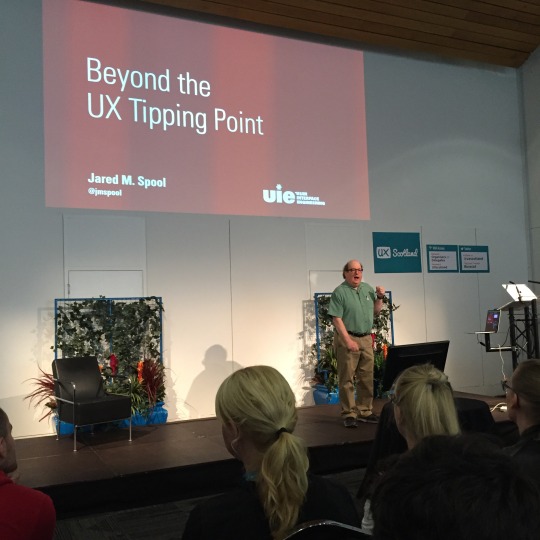
Keynote: Jared Spool
The opening keynote was by Jared Spool who, according to his wikipedia page, “is the founding principal of User Interface Engineering, a research, training, and consulting firm specializing in website and product usability, and the largest usability research organization of its kind in the world”. Spool’s talk “Beyond the UX Tipping Point” was on how user experience design can become embedded in organisations, and hence how they can come to make better products and services.
Spool's opening example was Disney, which in 1997 had a terrible website (look it up on the wayback machine). He used this website for years in his training as an example of poor design. He’d set tasks such as “find the cheapest hotel on the monorail line at Disney World”. Few people could complete this task, but worse about one in twenty people would identify a hotel thousands of miles away in Disneyland. This related to a real world problem for Disney who would find that people would arrive at one park with a reservation at another. They actually set aside a quota of rooms for people in this situation. So, how did Disney get from there to today's highly successful Magic Band given to customers?
Spool spoke about how individuals and organisations go through stages of understanding. From “unconscious incompetence” where they don’t recognise they’re getting things wrong, to mastery and “infused UX design”. He argued that to get there organisations need to be playbook driven rather than process driven.
VUI Design
The first session I went to was a hands-on workshop on Voice User Interface (VUI) Design led by Ben Sauer from Clearleft. This session focused mainly on designing for personal/home assistants such as Siri and Alexa. One of the key challenges in this area is that there are no/few affordances for voice apps - its not apparent what you can and can’t do. People forget what apps they have installed and what devices can do. Also, the technology is still far from perfect and so design needs to continually support “failing gracefully”.
Most voice interfaces are currently transactional or instruction driven - do this, do that. When designing these kinds of systems its helpful not to rush straight into prototyping an app, but to produce wizard of oz style systems. Its necessary to think and work through how people will pose questions and give commands and in what contexts, and so lo-fi wizard of oz studies enable you to rapidly gain insight into what people say. Apparently for designing Alexa apps you need to specify all the ways in which a question or command might be posed.
Behavioural Economics and Choice
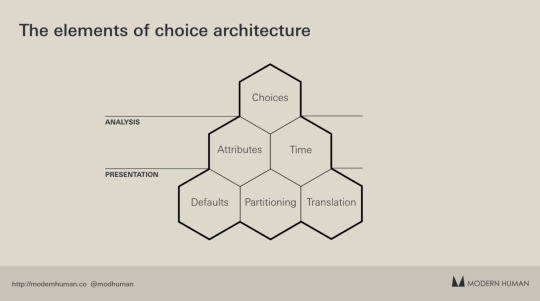
After lunch I went to a talk by Paul Jervis Heath on "Bounded Rationality and the Architecture of Choice: Applying Behavioural Economics to User Experience Design” . Behavioural economics is "the science of how people make decisions - how people really think and make decisions”. Kahneman, one of the founders of the field, explained “I’m much more interested in natural stupidity than artificial intelligence.” Jervis Health spoke about cognitive biases, and then “choice architecture” - the ways in which choices can be presented in order to nudge but not force people into making a particular decision and even making a decision at all. One of the key things in this area seems to be not guiding people to a specific choice but ensuring they make a choice - i.e. that they make a purchase.
Myths of UX
Following that I went to a talk by Zoltan Kollin on the myths of UX design. He presented a series of counter examples to what we typically say are qualities of good design (e.g. consistency, frictionless, intuitiveness, simplicity). The examples included shoelaces, which require years of learning; ATMs which only dispense money once the card is retrieved, keyboards which slow you down, and Reddit and Facebook which have cluttered, complex interfaces.
Designing for Closure
Finally I went to a session by Anna Wojtczuk from Scott Logic on "Letting your customers go: Designing for closure”. Wojtczuk explained that opening and on boarding experiences these days are often extremely well designed but closures and endings are not. She discussed the work of Joe MacLeod on closure experiences and recommended a book he has coming out called Ends.
Wojtczuk focused on one kind of closure: withdrawals. This is where you end a subscription or membership of a service. Often its made very difficult to withdraw, for example Virgin used to make you telephone them in order to cancel, and sites including Amazon still make it very difficult to find where to delete an account. However, endings are important and people may want or need to leave for a variety of reasons. A poor ending experience may lead to people not wanting to come back and not recommending you to others. She drew analogies with fairy tales and how customers can end on a “happy ever after”.
0 notes
Text
Data Relationships Workshop at CHI 2017
Our Quantified Data and Social Relationships workshop at CHI2017 addressed the question:
How do we design for shared interactions and experiences with data, which acknowledge the messiness, intricacies, transitions and sensitivities within human relationships?
I thought the workshop was a success. The format worked well. The workshop began with short presentations of the 12 accepted papers followed by panel discussions (as opposed to individual Q+A at the end of each talk). Following that we used ideation cards and ‘speed dating’ to develop some interesting and creative scenarios and accounts of ‘data relationships’.
Accepted papers from the workshop are available here: https://openlab.ncl.ac.uk/datarelationships/accepted-papers/
I co-organised this workshop with Chris Elsden & Abigail Durrant (Newcastle), Aisling O’Kane & Paul Marshall (UCL), Rowanne Fleck (Birmingham), and Deborah Lupton (Canberra). Chris was the mastermind behind the whole thing.
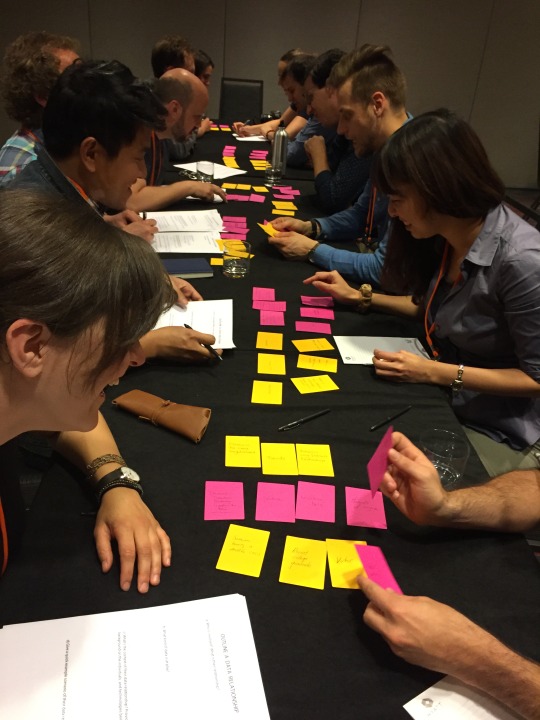
0 notes
Text
My CHI 2017 picks
I’m just back from CHI 2017 in Denver. Here are my top picks from the conference (so far - I’ve not read everything). Its been a good year, so the list is longer than usual...
Papers on personal tracking
Naomi Yamashita, Hideaki Kuzuoka, Keiji Hirata, Takashi Kudo, Eiji Aramaki, Kazuki Hattori Changing Moods: How Manual Tracking by Family Caregivers Improve Caring and Family Communication
Tracking of by one family member of another with depression. interestingly/controversially the subject of tracking does not have direct access to the logs.
Elizabeth V. Eikey, Madhu C. Reddy. It's Definitely Been a Journey: A Qualitative Study on How Women with Eating Disorders Use Weight Loss Apps
Interesting study of the use of My Fitness Pal by women with eating disorders. Many interesting design suggestions.
Jochen Meyer, Merlin Wasmann, Wilko Heuten, Abdallah El Ali, Susanne CJ Boll. Identification and Classification of Usage Patterns in Long-Term Activity Tracking
A nice study of usage patterns with activity trackers. The paper looks in a fairly simply ways at whether an app was looked at or not.
Ravi Karkar, Jessica Schroeder, Daniel A Epstein, Laura R Pina, Jeffrey Scofield, James Fogarty, Julie A Kientz, Sean A Munson, Roger Vilardaga, Jasmine Zia. TummyTrials: A Feasibility Study of Using Self-Experimentation to Detect Individualized Food Triggers.
This a great paper that brings principled self experimentation to personal tracking. The authors have created and trialled an app to support self experimentation by people with irritable bowel syndrome.
Ruth Ravichandran, Sang-Wha Sien, Shwetak N Patel, Julie Kientz, Laura R. Pina. Making Sense of Sleep Sensors: How Sleep Sensing Technologies both Support and Potentially Undermine Sleep Health
This paper presents a survey and interview study with people that use sleep trackers and several interviews with health professionals. The authors make some very interesting points about measurement.
Daniel A Epstein, Nicole B Lee, Jennifer H Kang, Elena Agapie, Jessica Schroeder, Laura Pina, James Fogarty, Julie A. Kientz, Sean Munson. Examining Menstrual Tracking to Inform the Design of Personal Informatics Tools
A broad study of menstrual tracking apps that makes some interesting points on gender.
Amid Ayobi, Paul Marshall, Anna L. Cox, Yunan Chen. Quantifying the Body and Caring for the Mind: Self-Tracking in Multiple Sclerosis
This is an interesting study of self tracking by people with degenerative disorders. The paper considers the mindful and lived aspects of tracking along with the more functional aspects.
Chia-Fang Chung, Nanna Jensen, Irina A Shklovski, Sean Munson. Finding the Right Fit: Understanding Health Tracking in Workplace Wellness Programs
A systematic take on tracking in workplace wellness initiatives.
Papers related to mindfulness
Bin Zhu, Anders Hedman, Haibo Li. Designing Digital Mindfulness: Presence-In and Presence-With versus Presence-Through
This paper presents a helpful framework for designers describing different ‘levels’ of mindfulness technology.
Christina Kelley, Bongshin Lee, Lauren Wilcox. Self-tracking for Mental Wellness: Understanding Expert Perspectives and Student Experiences
A paper on self tracking for stress management and mental wellness among students, focusing on the challenges of uptake.
Petr Slovák, Christopher Frauenberger, Geraldine Fitzpatrick. Reflective Practicum: a Framework of Sensitising Concepts to Design for Transformative Reflection
The paper considers two examples of ‘social emotional learning’ (a counselling course, and a primary school life skills programme) through the lens of Schön’s work.
Blockchain and Bitcoin
Larissa Pschetz, Ella Tallyn, Rory Gianni, Chris Speed. Bitbarista: Exploring Perceptions of Data Transactions in the Internet of Things.
Interesting work with a bitcoin integrated coffee machine showing provenance data.
Karim Jabbar, Pernille Bjorn. Growing the Blockchain Information Infrastructure
A study of a Bitcoin entrepreneur setting up bitcoin ATMs and payments infrastructure in Denmark.
Corina Sas, Irni Eliana Khairuddin. Design for Trust: An Exploration of the Challenges and Opportunities of Bitcoin Users
Interesting study of Bitcoin users and issues of trust out there in the wild.
Papers on messaging
Mariam Hassib, Daniel Buschek, Paweđ W WoƝniak, Florian Alt. HeartChat: Heart Rate Augmented Mobile Chat to Support Empathy and Awareness
The creation and trial of an app in which biometrics and mobile messaging are combined.
Katerina L. Gorkovenko, Nick Taylor, Jon Rogers. Social Printers: A Physical Social Network for Political Debates.
Interesting design study in which social printers were placed in the home.
Frank R. Bentley, Nediyana Daskalova, Nazanin Andalibi. “If a Person is Emailing You, It Just Doesn't Make Sense”: Exploring Changing Consumer Behaviors in Email
This paper considers what email is to people these days, when messaging apps are so widely used. Email is now primarily for relationships with business, such as collection of receipts and coupons.
Rui Zhou, Jasmine Hentschel, Neha Kumar. Goodbye Text, Hello Emoji: Mobile Communication on WeChat in China
A qualitative study looking at sticker and emoji based messaging in China.
Reviews
Joe Marshall, Conor Linehan. Misrepresentation of Health Research in Exertion Games Literature
A lot of health related research is misrepresented when describing the reasons for creating exertion technology.
Ari Schlesinger, W. Keith Edwards, Rebecca E. Grinter. Intersectional HCI: Engaging Identity through Gender, Race, and Class
A meta review of identify representation in the HCI literature.
Method
Chris Elsden, David Chatting, Abigail C. Durrant, Bettina Nissen, Andrew Garbett, John Vines, David S. Kirk. On Speculative Enactments
Design fiction meets user studies.
Barry Brown, Eric Laurier. The Trouble with Autopilots: Assisted and Autonomous Driving on the Social Road
A methodologically interesting paper using YouTube as a source of data.
Papers on “Datawork”
Melanie Feinberg. A Design Perspective on Data
We should think of data not just in terms of use and representation, but in terms of its creation and design.
Peter Tolmie, Rob N Procter, David William Randall, Mark Rouncefield, Christian Burger, Geraldine Wong Sak Hoi, Arkaitz Zubiaga, Maria Liakata. Supporting the Use of User Generated Content in Journalistic Practice
A study of journalists use of data tools, showing amongst other things that they do not simply take the output of these tools at face value but combine sources of information and treat them sceptically.
Nadia Boukhelifa, Marc-Emmanuel Perrin, Samuel Huron, James Eagan. How Data Workers Cope with Uncertainty: A Task Characterisation Study
Introduces (to me at least) the idea of “data work” and “data workers”.
Posters
Asma Ghandeharioun, Rosalind Picard. BrightBeat: Effortlessly Influencing Breathing for Cultivating Calmness and Focus
Work that reminded me of Tina Bin Zhu’s paper on mindfulness (above).
Ziming Wu, Xiaojuan Ma. Money as a Social Currency to Manage Group Dynamics: Red Packet Gifting in Chinese Online Communities
Interesting on WeChat payments/gifting.
Grace Eden, Benjamin Nanchen, Randolf Ramseyer, Florian Evéquoz. On the Road with an Autonomous Passenger Shuttle: Integration in Public Spaces
An interesting perspective on autonomous vehicles, taking a passengering and pedestrian view of how autonomy comes to be.
0 notes
Text
Curtains Messenger
Curtains Messenger is a synchronous text messaging app for Android and iOS. Its available here: https://curtainsmessenger.com/
Give it a go!
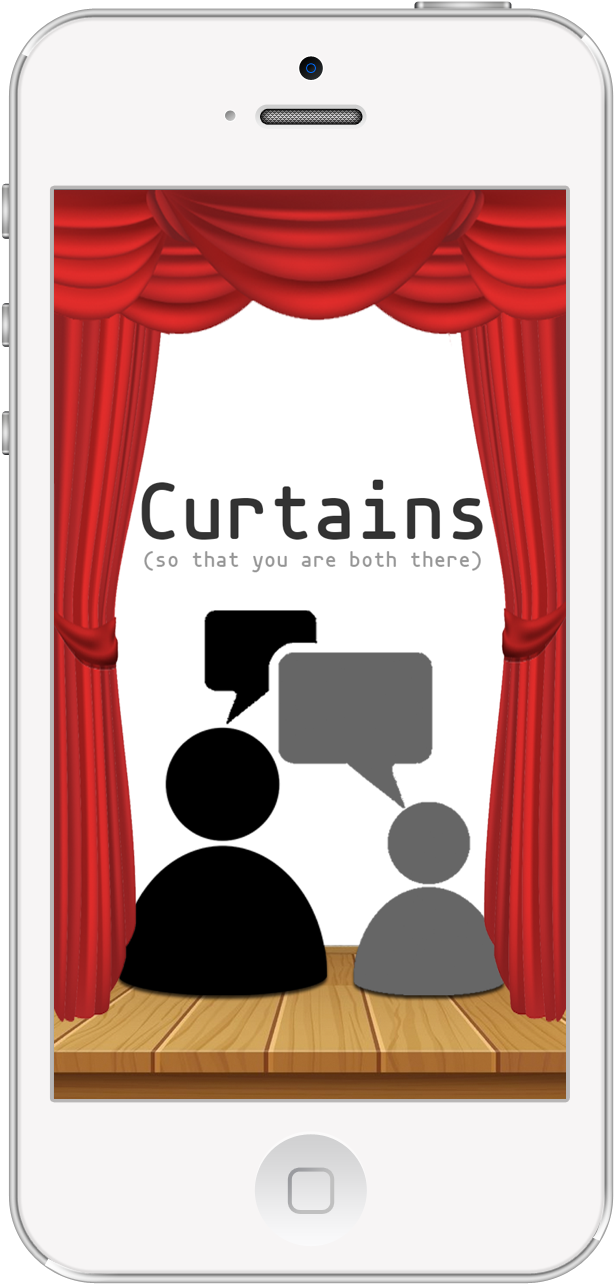
0 notes
Text
Physical Activity App Store Apps: How Can We Evaluate their Effectiveness?
Claire McCallum is presenting work at the UCL Centre for Behaviour Change Digital Health Conference this week on “Physical Activity App Store Apps: How Can We Evaluate their Effectiveness?”
McCallum C, Asadzadeh P, Rooksby J, Chalmers M and Gray C (2017). Physical Activity App Store Apps: How Can We Evaluate their Effectiveness?. Front. Public Health. Conference Abstract: 3rd UCL Centre for Behaviour Change Digital Health Conference 2017: Harnessing digital technology for behaviour change. doi: 10.3389/conf.FPUBH.2017.03.00059
0 notes
Text
Quantified Data and Social Relationships
I’m co-organising a workshop on “Quantified Data and Social Relationships” at CHI2017 in Denver. More information here.
0 notes
Text
Talking Bitcoin with school kids

I was asked by a local school to come and talk with some 13 to 14 year olds about Computer Science. Because I would be talking to groups of children, and because I wasn’t sure about what infrastructure there’d be, I thought rather than do something at the screen it would be good to do something more practical and discussion based.
An idea I’ve been mulling over for a while now is how the concepts behind Bitcoin provide a route into some important topics in computing - cryptography, logic, distributed systems, data structures, maths, trust, social disruption and so on. My thinking has always been that it would be good to do some lectures at university level on this, but given the chance to talk to some school kids I thought I might give this a go. Can I make some complex topics in computing seem accessible and exciting?
Well, I kind of pulled it off. I gave six 20 minute sessions with groups of about 10 children. The format was pretty much:
Many inventions in computing are changing the world, and Bitcoin might be the next one to do so.
How can a bitcoin have value? We need ledgers or people could just copy and copy bitcoins and they wouldn’t have any value.
What if instead of having a bank controlling the ledgers, we did this ourselves as a community?
In computing we need to think about data structures. We can represent ledgers in various ways, but a transaction based format might be best in this case.
To buy and sell we need to send out messages to everyone in the community. But everyone can see these messages, and we need to all have unique account numbers. So cryptography is very important.
But what if someone tried to spend their bitcoin twice, we need a way of deciding which payments are valid. Therefore a transaction needs to go into a block before it is finalised (again thinking about data structures).
But only one person in the community can decide what goes in the block, so we have a competition. The person that wins, decides what goes in the block and they also get a new bitcoin.
Trust and consensus is very important in bitcoin, its a new way of thinking about money.
Do you think we might start using bitcoins instead of pounds in the future? What other inventions in Computing Science are changing the world?
With groups of 10, its quite easy to use bits of paper to hand out messages and stick them into blocks. It less easy to get through this amount of stuff in 20 minutes. I think though that the emphasis on invention and interdisciplinarity in Computing can come across well.
What I realise however, is that children of this age don’t necessarily have a good grasp of some things I take for granted - what banking is, what charts and tables are, what a network is.
Another thing I realised is that a similar session run by an architect involved the children using cocktail sticks and fruit pastels to build a structure, which they could then eat. One of the kids told me that that was sssoooo much better!
The main answer to my question “what other inventions in Computing Science are changing the world” was ... “The Ps4″.
0 notes
Text
OzCHI 2016
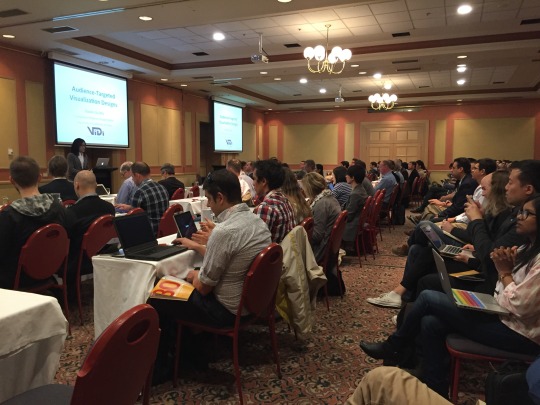
I attended OzCHI in Launceston, Tasmania in late November/ early December 2016. The conference was excellent. Its not one of the top ranked HCI conferences, but the standard was high and many leaders in the field were there. One of the remarkable things about the conference is that many Australian academics make an effort to attend the conference whether or not they’re presenting work. It also had a strong emphasis on student work with many of the presentations being of short papers written by students.
There were three keynotes. Firstly Kwan-Liu Ma (UC Davis) talked about his work on visualisation, emphasising how work in this area differs depending on audience and context. He contrasted visualisation in scientific research with visualisation for an interactive exhibit in a science museum.
Secondly Kun Pyo Lee (KAIST) talked about how design at KAIST is moving into a new era. Designers are currently facing something of a crisis - for example industrial designers are faced with the issue that most new phones and televisions are a screen and little else, and graphic designers are being ousted in favour of crowd sourced work (e.g. the Tokyo Olympics logo). “Design 3.0”, said Lee, needs to embrace rather than ignore these trends, and designers need to focus not on finished products but configurable objects upon which makers can build.
The third keynote was Kirsha Kaechele (MONA). She is an artist who did a lot of architectural and community based work in New Orleans. She discussed how she is building upon her work to do things like build an underground bunker to house a “hacking school”, and plans to disrupt the gambling industry by building inverted fruit machines that pay out to communities rather than take away.
There were also two very good panel sessions, one on “New Opportunities in HCI and Digital Health”, and the other on “Back to the Future: Fiction Inspiring Design”.
0 notes
Text
Paper at OzCHI 2016
Our paper Implementing Ethics for a Mobile App Deployment has been accepted for OzCHI 2016.
Implementing Ethics for a Mobile App Deployment
John Rooksby, Parvin Asadzadeh, Alistair Morrison, Claire McCallum, Cindy Gray, Matthew Chalmers
This paper discusses the ethical dimensions of a research project in which we deployed a personal tracking app on the Apple App Store and collected data from users with whom we had little or no direct contact. We describe the in-app functionality we created for supporting consent and withdrawal, our approach to privacy, our navigation of a formal ethical review, and navigation of the Apple approval process. We highlight two key issues for deployment-based research. Firstly, that it involves addressing multiple, sometimes conflicting ethical principles and guidelines. Secondly, that research ethics are not readily separable from design, but the two are enmeshed. As such, we argue that in-action and situational perspectives on research ethics are relevant to deployment-based research, even where the technology is relatively mundane. We also argue that it is desirable to produce and share relevant design knowledge and embed in-action and situational approaches in design activities.
0 notes
Text
UX at Facebook
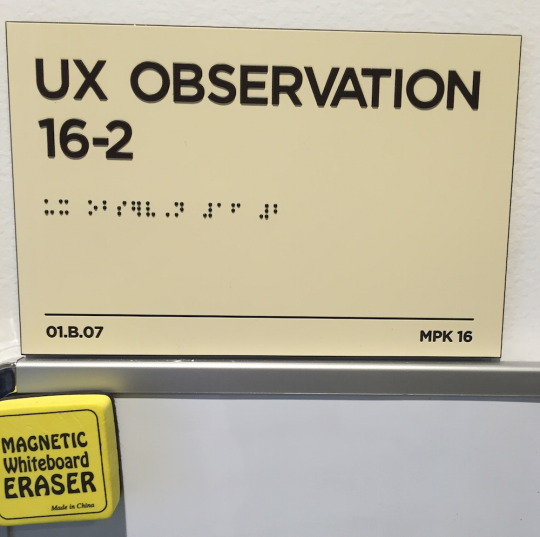
I visited Facebook HQ in May 2016 to meet the User Research / UX team and view their labs. The team seems to be involved in all sorts of things, from investigating and evaluating new products and features, running interviews and focus groups, and optimising adverts. Some of their work seems to be exploratory, some to investigate more specific issues and questions, and some to facilitate developers in seeing how users react to specific new features. Their work doesn’t cover VR/Oculus, but seems to cover almost everything else. They also work separately to the data science team(s) - although I’m sure there is back and forth between them.
Their labs are set up with an emphasis on eye-tracking and video recording, with multiple cameras and boxes to combine multiple video streams. For videoing on mobile, they have a perspex stand with a small camera mounted on it. They have a couple of formal boardroom style areas, and a more relaxed looking room with sofas and windows - which is apparently is a lot less intimidating for participants.
They are also able to do interviews and observations with remote users, using screen recording. Remote research is conducted by researchers in the lab.
UX work is clearly valued at Facebook, with a lot of investment in the labs - and staff as well (including technical/AV staff).

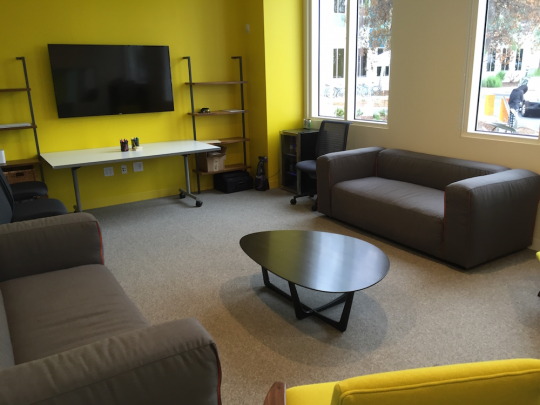
1 note
·
View note
Text
WISH 2016
I attended WISH 2016 (Workshop on Interactive Systems in Healthcare) at CHI2016 in San Jose yesterday. WISH has been running for a few years and seeks to bring together the HCI and Health Informatics communities. It has previously been hosted by the AMIA American Medical Informatics Association conference as well as CHI. The workshop had a refreshing focus on the work of junior researchers and PhDs (many of whom were assigned mentors for the workshop, to help them develop their papers and to go out for lunch with). To encourage communication between communities, the workshop included presentations of work published elsewhere (e.g. JAMIA), as well as works-in-progress.
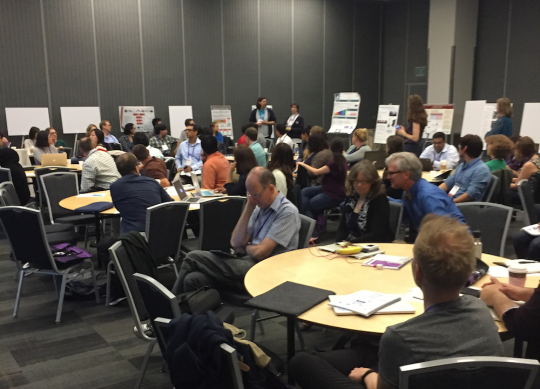
There were two keynotes. Jonathon Nebeker (Professor of Medicine, University Utah) addressed that longstanding question in health informatics “Why do electronic health records suck?” He presented his work on “Theory enriched design” of health records. This approach encompasses:
Development of the product concept: what does the user need to do? (not just information needs, but their processes and trajectories too)
Consideration of the “joint cognitive system”.
Mechanisms and principles to support cognitive flow
Feature compression
Mary Czerwinski (Microsoft Research) spoke about “Technology for healthy habit formation”, concentrating on four of the more successful systems her group has created in recent years for promoting emotional health. Her key points were:
Treatment for most health conditions requires behavioural change (Just showing data without suggestions for change generates negative outcomes).
Digital micro-interventions based on psychological theories can lead to positive outcomes
The hard problems are: a) accurate sensing of emotions, b) attracting and retaining users, c) creating personalised machine learning algorithms.
There were many good papers and posters at the workshop. Three highlights (from my perspective) were: Francisco Nunes’ talk about his IJHCS paper on “self care and collaboration”. Ravi Karkar’s discussion of his JAMIA paper on self experimentation in personalised health. Maia Jacob’s study of tablet use by people being treated for breast cancer.
At the workshop I presented a poster about the EuroFIT programme (below).
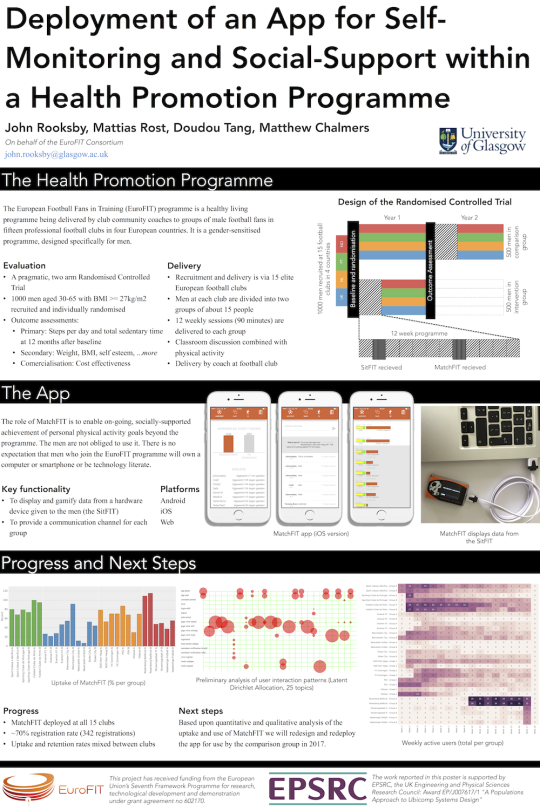
1 note
·
View note
Text
Poster at Behaviour Change Conference
Claire McCallum presented this poster at the 2nd Behaviour Change Conference: Digital Health and Wellbeing (23 - 24th Feb, 2016, London).
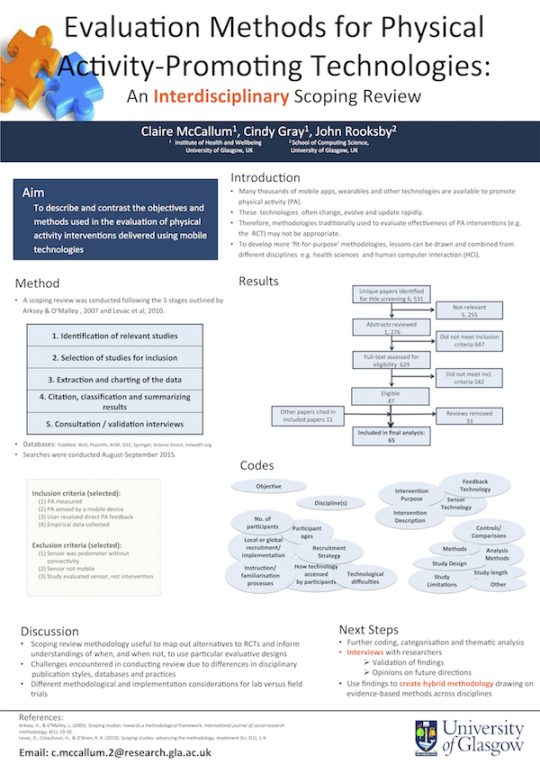
0 notes
Text
Public Health Workshop - Exploring Physical Activity for Health and Fun
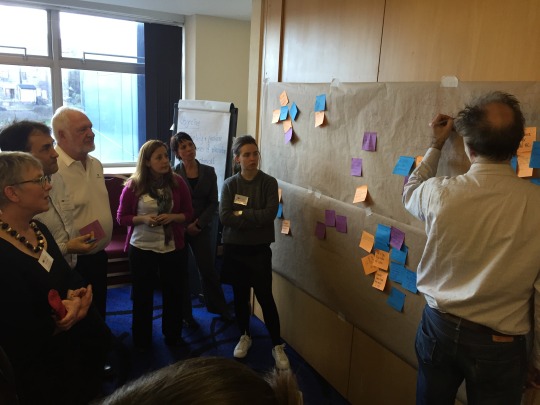
On the 10th March 2016 I attend “Public Heath Workshop - Exploring Physical Activity for Health and Fun” at Hampden Park in Glasgow.
The workshop was organised by the EU Directorate General for Research and Innovation, and members of the EU funded EuroFIT project. The purpose was to bring together researchers from several EU-funded public health projects, including:
EuroFIT: Social innovation to improve physical activity and sedentary behaviour through elite European football
Credits 4 Health
SitLess
PASTA: Physical Activity Through Sustainable Transport Approaches
REPOPA: Research Into Policy to Enhance Physical Activity
The workshop featured a keynote talk by Nanette Mutrie from the University of Edinburgh, talks about each of the projects, and several breakout discussion sessions.
0 notes
Text
EU projects linking ICT and Physical Activity
The following list of “relevant projects linking ICT and physical activity” was given In a talk from the EU Directorate General for Research and Innovation at a workshop I attended yesterday.
BeatHealth: Health and Wellness on the Beat
PAL: Personal Assistant for a Healthy Lifestyle
Pathway: Technology enabled behavioural change as a pathway towards better self-management of CVD
PEGASO Fit for Future: Personalised guidance services for optimising lifestyle in teenagers through awareness, motivation and engagement
Precious: PREventive Care Infrastructure based On Ubiquitous Sensing
Semeioticons: SEMEiotic Oriented Technology for Individual’s CardiOmetabolic risk self-assessmeNt and Self-monitoring
Splendid: Personalised Guide for Eating and Activity Behaviour for the Prevention of Obesity and Eating Disorders
Alfred: Personal Interactive Assistant for Independent Living and Active Ageing
Acanto
Elf@home
Fate: Fall detector for the elderly
ISTOPPFALLS: ICT Based System to Predict and Prevent Falls
Profound: Prevention of Falls Network for Dissemination
0 notes
Text
Quped App Release

I’ve worked with Parvin Asadzadeh, Claire McCallum and others on the development of a new pedometer app for iPhone. Quped has been released for iPhone. It can be found by searching for "Quped" on the Apple App Store or via the Quped website.
0 notes
Text
Paper accepted for CHI2016
Our paper:
John Rooksby, Parvin Asadzadeh, Mattias Rost, Alistair Morrison and Matthew Chalmers “Personal Tracking of Screen Time Across Multiple Devices”
has been provisionally accepted to CHI 2016 in San Jose. Its about a trial of a personal informatics app called ScreenLife that we developed and deployed over the summer that enables users to quantify the time they’re spending on their laptops and mobile devices.
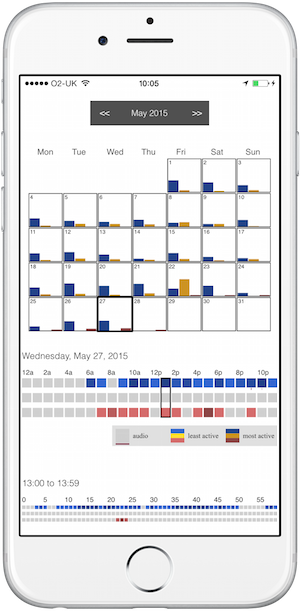
1 note
·
View note